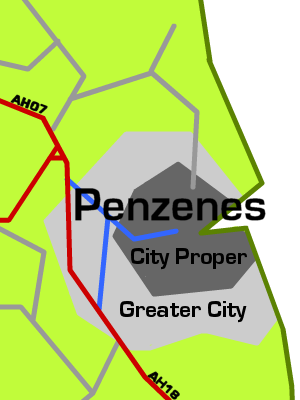Penzenes
| Penzenes | |||||
|---|---|---|---|---|---|

| |||||
| Nation | Germanalasia | ||||
| Function | Largest city by population. | ||||
| Population - City Proper - Greater City |
Approx 11 million Approx 18 million | ||||
Penzenes is the largest city by population in Germanalasia. It has a very long history, and prior to the marriage of the King of Penzenes into Gerandara's Royal Family in the 7th Century was an independent city-state.
Penzenes is considered vastly different to the stereotypical Germanalasian city. The City Proper retains a vast amount of historical architecture, compared to the typical Germanalasian ideal of 'modern is better', and it is moderately unindustrialised. The setting of a major trading port juxtaposed against the only real tourist sites in the country has sometimes caused the outsider to beg the question as to whether the Germanalasian government is, in fact, de facto ruler as much as de jure.
Contents
Districts
Penzenes is divided into two broad areas, the central City Proper and the wider Greater City. Additionally, the Port Sector denotes the eastern-most fringes of the city, covering the ports and the immediate surroundings.
City Proper
The completion of the original city wall around Penzenes occurred in 514 CE in order to ensure the protection of the city state from it's expanding neighbours. At the time of its construction, it was the most ambitious military-related project the city had undertaken. By 620 CE, however, the city had expanded outside of the walls to such a degree that a second wall was built and the first abandoned. Eight further walls followed it, the most recent being completed in autumn 1699. It was at this point that the City Proper was defined as the city within these walls.
The older walls fell rapidly into disrepair as each new one replaced it, with only a few sections of the disused fortifications remaining today. The existing outer wall to the City Proper has not been manned for several centuries, but it is maintained to some degree from structural weaknesses to prevent against any damage from the surroundings should the wall crumble in some manner. The gates have all since been removed to make way for larger motorways and wider lanes, although the main gate's doors and hinges have been preserved in The Penzenes Museum.
The City Proper lacks the skyscrapers and metropolitan buildings of other Germanalasian cities, but still retains the densely packed apartment blocks, albeit of fewer stories and cast in bricks and mortar more than steel, concrete and glass. Numerous shopping complexes have been built, merging the historic architecture of Penzenes with the rest of Germanalasia's thirst for modern and art-deco design.
Greater City
While resembling much more closely the Germanalasian stereotype of tall, blocky buildings of offices and apartments than the City Proper, its loose, unstructured tangle of roads and vast variations in the sizes of these buildings still marks it different from cities such as Beranostra. The Greater City, while housing the majority of Penzenes' population, has far fewer shopping complexes than the city proper - however, as the majority of supermarkets in the area offer rapid, free delivery services, this is not off-putting to buyers. It serves as the city's primary industrial sector - good communications with the rest of the nation and abroad have all aided this.
The Greater City is regularly expanding. In 2005 alone, planning permission was granted for twenty-nine large apartment blocks and over forty office buildings, not to mention the large number of warehouses that get built annually. Land at the extreme peripherals of the city is becoming more expensive because of the demand, which is suspected to reduce the expansion of the city somewhat, but not drastically.
Attractions
While the preservation of numerous examples of historic architecture is certainly the fundamental reason why Penzenes remains a tourist draw, its sea access has encouraged many cruise lines to use it as a stop-off point, and some cruise services are even run from there. Its moderately large airport does not affect this, particularly, as it is exclusively used for cargo transportation.
The major tourist draws to the city include:
The Penzenes Museum
- Main Article: The Penzenes Museum
The only museum in the country that is partially funded by the government, and certainly the largest, The Penzenes Museum (sometimes called TPM by employees) hosts exhibits on a wide range of historical topics, including wings on Germanalasian and Global Natural History, Artistic History, and Germanalasian Military History.
The building itself is something of a historical artefact. It was originally the Royal Palace for the royal line of Penzenes, then later a secondary palace for the royal line of Germanalasia. It was expanded numerous times over the years, but for several generations before the death of the monarchy it had remained completely uninhabited, but maintained by the household staff. After the last Germanalasian King died with no heir, it was converted by the government into the museum it is still today.
It is believed that a complex network of underground catacombs were installed as part of the Palace's construction for various reasons - hiding places, store rooms, and secret meeting sites. While these may be only used when the building was still a Palace, the Germanalasian Military Secrecy Act prohibits the government confirming or denying the existence of any such network.
The Mathematician's Honeycomb
Lying under a recently constructed high, partially glass, roof to prevent further erosion, The Mathematician's Honeycomb is a large, natural construction of predominantly hexagonal and pentagonal basalt columns, interlocking, formed from the cracking of the surface of an ancient lava flow. The columns were made more distinct by erosion from the elements.
Named after its similarity to bee's honeycomb and because of its geometric shapes, the site lines the sides of the valley and consists of approximately fifty thousand individual columns.
